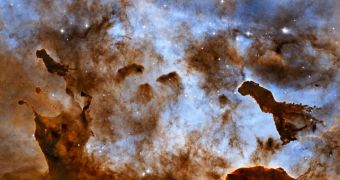Astronomers operating the Hubble Space Telescope recently captured a new view of the renowned Carina Nebula, one that shows the cosmic structures in a way no one has seen before.
The formation, which is located an estimated 7,500 light-years away from our solar system, reveals impressive pillars of cosmic dust and hydrogen gas to Hubble's prying eyes.
The telescope cannot pierce the cloak surrounding the stars inside the Carina Nebula, because it conducts observations in visible and ultraviolet wavelengths only.
Only an infrared, X-ray or radio telescope can peer inside structures that are entirely enveloped in dust. But Hubble did snap an impressive view, which reveals the back-lit clouds in exquisite details.
The structures revealed in the Hubble photograph are however not very large by cosmic standards. They are not even large by Carina standards, the team that made the finding says.
Regardless, the pillars that were recently imaged are no less than a light-year tall, which means that they span a distance 60,000 times longer than that separating the Earth and the Sun.
Translated into more earthly units of measurement, the pillars are an estimated 9.7 trillion kilometers, or 6 trillion miles high. Many pillars in Carina grow to three times that size.
According to astrophysicists, it would appear that the pillar-like structures differentiated from the nebula under the influence of strong stellar winds and radiation, emitted by the stars within.
Inside nebulae, collapsing clouds of gas and dust constantly produce new stars, which then proceed to wreak havoc in their surroundings. Carina is no exception to that rule.
One could argue that the cosmic structure captured the imagination of scientists and the general public because of the peculiar shapes its gas clouds take on.
The attached Hubble view contains video data that were collected in 2005, and again very recently. This allows the impressive wealth of detail that can be clearly seen in the new photo.
In its entirety, the nebula spans an estimated 100 light-years. This makes it more than four times larger than the renowned Orion Nebula, which was also brought in the public eye by Hubble.
According to astronomers who studied Carina in the past, the stellar nursery may be home to dozens massive stars, each of them 50 to 100 times more massive than the Sun, Space reports.

 14 DAY TRIAL //
14 DAY TRIAL //